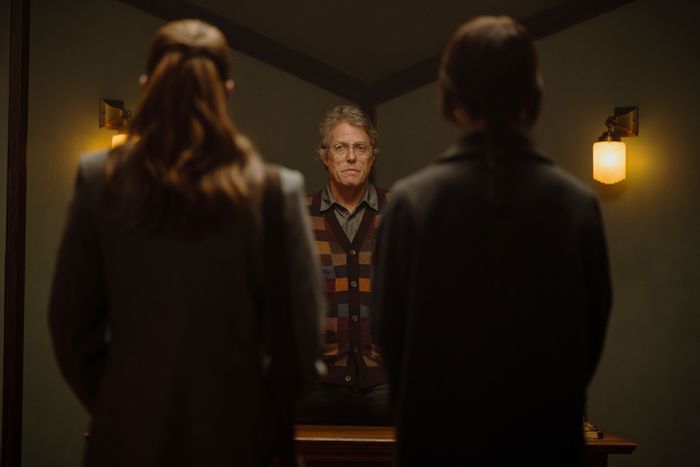
A week before the wide release of Heretic, audiences in select theaters did more than just watch and listen to the new A24 horror flick. They also smelled it, thanks to a stab at a gimmick that movie theaters have tried to make happen several times with limited success. Viewers who didnÔÇÖt sniff out these blueberry-scented screenings wonÔÇÖt be missing anything essential when Heretic opens, odorless, on November 8. But the filmÔÇÖs brief deployment of modern-day Smell-O-Vision didnÔÇÖt stink, for once ÔÇö it was actually a surprisingly effective marriage of screen and smell.
The smell in Heretic (thereÔÇÖs only one) came courtesy of Joya, a company thatÔÇÖs previously partnered with A24 for branded candles. Anybody who has ever given themselves a headache sniffing absurdly specific scented candles at a store knows that thereÔÇÖs invariably some artificiality to these concocted scents. Yankee Candle can make something smell eerily like pumpkin-banana scones, but youÔÇÖre not going to be fooled into actually thinking thereÔÇÖs fresh-baked goods in the oven. Scents in a movie theater face this problem, too. Rather than being immersive, smelling a mysteriously piped-in fragrance that might linger well after the accompanying onscreen moment has passed threatens to take audiences out of the moment.
HereticÔÇÖs ÔÇ£multisensory experienceÔÇØ worked because of how it weaponized this falseness and made it complement an onscreen twist. When Mormon missionaries Sister Barnes and Sister Paxton (played by Sophie Thatcher and Chloe East, respectively) first enter the house of their would-be convert, Mr. Reed (Hugh Grant), they do so only because he says his wife is in the kitchen baking a fresh blueberry pie. (To go into a manÔÇÖs house without another woman present would be against their missionary rules.) Mr. Reed returns from the kitchen claiming his wife is being shy, but heÔÇÖs brought soda and a candle to his living room for Barnes and Paxton to enjoy while they try to tell him about the Church of Jesus Christ of Latter-day Saints.
Its at this time, with the supposed pie baking in the other room, that the unmistakable, uncanny scent of gooey, sugary blueberry pie began to waft into the Alamo Drafthouse Cinema where Heretic was being screened. (Alamo already has a fairly distinct scent because of all the food, so for the theater to smell like blueberries meant those scented molecules had to be really working.) On the screen, Barnes and Paxton are beginning to grow uncomfortable at Mr. Reeds questions and his unseen wifes continued shyness. Their suspicions grow until he leaves the room, at which point Barnes turns the candle on the table around to see its  blueberry-pie scented. No one is baking in the other room, Mr. Reeds wife doesnt exist, and Barnes and Paxton are in trouble thats only going to get worse.
With that reveal, the nagging artificiality of the blueberries scent in the theater clicked into place. It was fake in the movie, too. (Alamo kind of undermined this moment minutes later when it served everybody an actual piece of blueberry pie, but itÔÇÖs hard to get too mad at a free dessert.)
Heretic directors Scott Beck and Bryan Woods explained via email that the scented screening was A24ÔÇÖs pitch, not theirs, but they approved it because ÔÇ£the idea of Smell-O-Vision felt tonally comical in a similar wayÔÇØ to their film.
Movies have been dabbling with smell since the silent era, with theaters experimenting with scented oils and flowery perfumes. A 1940 issue of Variety has an item about a theater in New York that was built with the ability to pump in scents in 1916; it was used once, for a short film called Story of the Flowers. That quick abandonment is a running theme in the history of movie smells, but by far the most famous (or infamous) stab at bringing a third sense to the screen was Smell-O-Vision. Developed from technology that made no impact when it bowed at the 1939 New York WorldÔÇÖs Fair, Smell-O-VisionÔÇÖs grand debut was with the 1960 film Scent of Mystery, which was written expressly to bust out more than a dozen scent cues. A competing stink technology, AromaRama, rushed to market to rival Smell-O-Vision and debuted with a 1959 movie called Behind the Great Wall.┬á
Both gimmicks were reviled. Scents lingered or came out at the wrong times or not at all, and different parts of theaters got hit with waves of odor at different times. Smell-O-Vision died, and scented cinema was from then on regarded as a foolish joke. John Waters, champion of kitsch and trash, evoked it by offering scratch-and-sniff cards to audiences of his 1981 film, Polyester. The fourth Spy Kids movie did the same, and a Vulture report from the time suggested it left a lot to be desired.
HereticÔÇÖs one-night-only scented screening is a promotional event rather than a proper release strategy, let alone a bold new vision for the future of cinema, but it makes sense that movies are revisiting the idea of heightened theatrical experiences. As theaters compete with streaming, theyÔÇÖre looking to enhance what they offer into something you canÔÇÖt get on your couch watching Netflix. RegalÔÇÖs 4DX, which helped launch Twisters to box-office success, does include some smells, though theyÔÇÖre secondary to the roller-coaster aspects of that experience.
That a multisensory experience works for Heretic suggests a very narrow set of circumstances for when smell truly works at the movies. ItÔÇÖs only because the blueberry-pie scent doesnÔÇÖt quite pass the sniff test that it, well, passes the sniff test. Still, even Beck and Woods admit itÔÇÖs not essential.
ÔÇ£Are these tactics necessary for movies as a whole? Maybe not,ÔÇØ the pair wrote. ÔÇ£But if you can couple a movie with occasional event gimmicks, we think it can be unique and special to draw people into the wonderful communal experience of seeing a film in a theater.ÔÇØ

